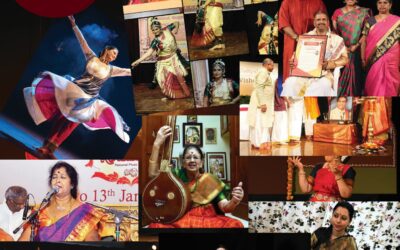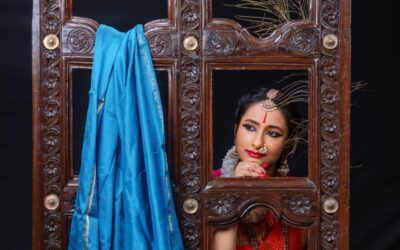Sri M.J.Srinivasa Iyengar, A Confluence of Values
Centenary Tribute
– Ranganath Chakravarthy
The centenary year celebrations of one of the great vaiNikas and premier exponents of the Mysore bAni, Sri M.J.Srinivasa Iyengar began in May 2023 and will conclude in May 2024. His hundredth birthday falls on May 20, 2024. MJS, as Srinivasa Iyengar was popularly known, enriched the Veena tradition with his unique mastery over the instrument. Besides being an artiste of exceptional merit and rare originality, he was a devoted and revered teacher. Above all, he led a simple life guided by lofty values which he adhered to unfailingly all his life.
There are, without doubt, many who have known Sri Srinivasa Iyengar far better and who are eminently more competent to speak about him than myself. However, this is a humble attempt to portray the life and times of a unique personality who remained in relative obscurity despite his immeasurable contribution to Carnatic music, especially to the glory of the Mysore Veena tradition. The aim is to enable succeeding generations to benefit from a glimpse into his greatness and accomplishment. This article is as well a poignant tribute to the memory of Sri M.S.Sheshadri, beloved son of MJS, who had requested me to write it on the occasion of the centenary. One feels an acute sense of loss and regret that this task could not be completed before his untimely and sudden demise.
Srinivasa Iyengar has been described by a senior disciple as someone who heralded the rejuvenation of the Mysore Veena tradition. His eminence derived from a combination of three vital factors, namely his abundant innate talent, the unmatched training and blessings of his great Guru Vidwan Veena Venkatagiriyappa who lovingly nurtured his prowess, and eventually MJS’ own efforts in developing his remarkable creative abilities.
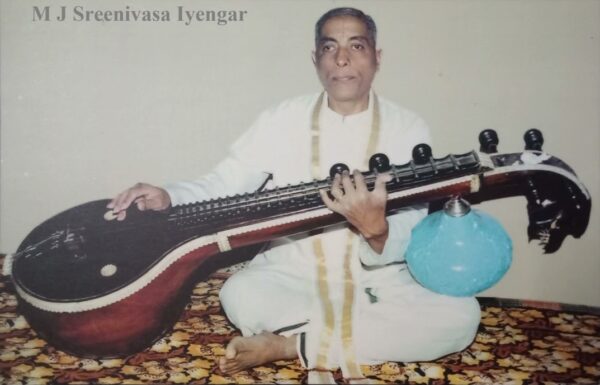
His style of AlApanA bestowed a special charm upon the rAgas, both the familiar and the rare ones. He specialised in manodharma-based kalpanA swaras and enjoyed the laya exercises.
His style was considered to be distinctly ‘gAyaki’, making it easy for the listener to identify and enjoy the sAhitya. He strove hard and successfully created a technique to match the intricate vocal rendition of the compositions. Many a connoisseur and performer has commented that one could hear the Veena “singing” when he played it. He attributed this aspect mainly to the influence of his favourite musicians GNB, Ariyakkudi and Alathur Brothers. He emphasised the techniques of “plucking” the strings, “gliding the fingers” and “cajoling” in order to retain the pristine and distinctive tone of the veena. To quote him, “there must always be coordination, synchronization and complementarity of all these intricate movements”. He maintained a slow or medium tempo, except when speed was warranted, so as to highlight the beauty of each sangathi. He was not averse to the idea of utilising innovative gadgets, especially the contact mike, but averred that they must be used judiciously. He firmly believed that nail caps must not be used as they tended to affect the feel of the swaras.
MJS bestowed a unique dignity to the swift gamakas of the Mysore bAni, by imbuing them with exceptional continuity and complexity. This made his music at once simple and weighty. As in life so in his music, he never resorted to extremes, thus maintaining exemplary equanimity.
MJS’ unassuming disposition was perhaps why his renown hardly matched his stature. It took other great musicians to recognise his class and give him the deserved credit for it. One such admirer was the redoubtable Dr.S.Balachandar who was captivated by his performance when he got the first opportunity to hear him. He is known to have written a letter to MJS subsequently, giving him the title of ‘Purvikalyani’ Srinivasa Iyengar! On a much earlier occasion, the revered Sri Mysore Vasudevachar praised him vociferously after attending his concert at Kalabhivardhini Sabha in Mysore. Most experts showered high praise on him for his innovative technique of playing the divine instrument.
As a teacher, MJS held and unwaveringly practised the firm belief that while the content of the teaching must not be sacrificed to accommodate the learners’ varying abilities, the method of teaching had to be adapted to suit them. He was way ahead of his times in that he employed the ‘non-correctional’ method which is a relatively modern concept. He made his students overcome their errors not by pointing them out but by making them realise where they were going wrong through their own repeated efforts and his demonstration of the right way of playing. Without deviating from the conventional method of teaching he yet managed to find ways off the beaten track to make the students understand the nuances better and more lastingly. For instance, he used to start teaching rAga AlApanA long before he had taught them several kritis. He was wont to teach each student individually, not in groups. He would play a rAga elaborately and make the student listen and observe intently. He would then teach a swarajati in the same rAga. This would help the student imbibe the essence of the rAga almost unconsciously! Such creative methods made him much loved as well as highly effective. That is perhaps also the reason why he developed a significantly larger number of students into able concert performers than most others before and during his time. The prominent names among them are A.S.Padma, M.K.Saraswathi, Mysore S.Rajalakshmi, M.K.Jayashree Prasad, Subhadra Nagaraj, Sudha Vadiraj and S.V.Sahana. Sahana is the youngest of them and learnt from him in the evening of his life.
The Ayyanar College of Music and Bhagini Seva Samaj in Mysore, and Chowdaiah Memorial School of Arts, T.Narasipur were enriched immensely by MJS’ service as a teacher there. He also taught the queen of HH Sri Jayachamaraja Wadiyar and the Maharaja’s daughter Gayatri Devi at their royal residence.
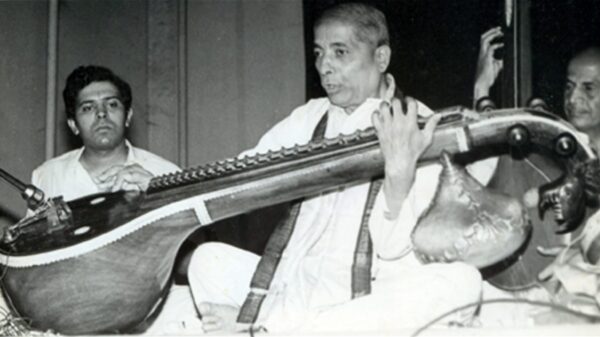
For all his scholarship and calibre as a musician, MJS was utterly unostentatious, an epitome of humility, kindness and generosity. He donated all the money that he got from awards towards endowments in music organisations and a school for the blind. His austere ways are likened to Mahatma Gandhi’s practice of ‘voluntary poverty’.
Among the honours that did come his way were the Karnataka Sangeetha Nritya Akademi Award in 1993, the Karnataka Rajyotsava Award in 1994 and the Kanaka Purandara Award in 2003 from the government of Karnataka. He was the first Vainika to receive the last-mentioned accolade. The government also gave him a monthly honorarium. Besides these, he presided over the prestigious annual conference of the Karnataka Gana Kala Parishat which conferred on him the title of Gana Kala Bhushana in 1992. He was the first ever recipient of the Ananya Lifetime Achievement award. The Chowdaiah memorial Kala Jyothi award is one among many others that he has been decorated with. His role as advisor to the Secondary Education Board helped significantly in shaping the prescribed text for the Senior level exams. MJS was one of the members of a quintet that performed at the inauguration of the Bangalore station of AIR. It was only natural that his scholarship and artistry were recognised with the A-Top grade in the following years. He was also a member of the Music Audition Board of AIR.
In the true spirit of recognising and honouring the arts, MJS dedicated the awards conferred on him to the innumerable artistes before him, during his lifetime and in the future who devoted their lives to the cause of music. His credo was that the artiste had two major responsibilities, one to zealously guard the traditions of our arts and two, to faithfully pass them on to the next generation for perpetuity. Both these require the qualities of selflessness and the humility to realise that the artiste is but an instrument for preserving and perpetuating the art.
Born in Bangalore, MJS lost his mother Smt.Janakamma when he was but four years old. His father Sri Janardana Iyengar decided to move to the village Doddamagge in Arkalagud Taluk in Hassan district. He gave MJS his initial training in vocal music. A fascinating sidelight of that initiation was the use of the bell of his bicycle as an improvised metronome for inculcating the sense of laya! MJS had unfortunately to give up singing when his voice was impaired by a severe bout of tonsilitis that could not be cured for want of proper medical treatment in the village. Therefore, when he was fourteen, Janardana Iyengar decided to put him in the care of the Sri Venkatagiriyappa at Mysore. Thus began the most decisive chapter of his life. Vocal music’s loss turned out to be the veena’s gain, a blessing in disguise as it were for the world of music.
The impecunious state of the family imposed daunting difficulties in his pursuit of education. During his years as a student of music in Mysore, he had to make do with sparse accommodation and just one meal a day, even that being not always assured. He owed much to the ParakAla Mutt where he used to obtain his daily lunch through all of his student years. In grateful acknowledgement of that, his family has made noteworthy donations to the Mutt and continues to do so. Although MJS’ academic education stopped after the lower secondary level, it paved the way for his mighty growth as a musician. He lived in a room in the house of a relative, close to his Guru’s residence. This enabled him to commute without impediment and also to be of service to his teacher.
As is well known, Vidwan Venkatagiriyappa was a direct disciple of the legendary Sri Veena Seshanna. Having inherited such a rich legacy, he wholeheartedly passed on style and substance to his disciples. He thus gave to the world illustrious maestros who would become luminaries in their own time, including Padma Bhushan Dr.Doreswamy Iyengar, R.N.Doreswamy, V.Venkatasubba Rao and V.Desikachar besides MJS himself. His way of teaching precluded notes and notations and thereby set much store by extraordinary powers of observation, retention and revision by the disciple. MJS used to make sure that he played the day’s lesson several times over in his mind as he walked back home from class. He spared no effort to reproduce the learning sincerely in the next day’s class. One of the aphorisms of music is that listening is key to learning, yet it bears repetition time and again. It was especially true at least until his generation when personal recording gadgets had yet to make their advent. He had a tremendous ability to quickly assimilate and build upon what he heard both in the class and in concerts.
During those difficult times, MJS also learnt invaluable lessons in life. The strength to endure suffering, forbearance, self-confidence and the courage to face adversities in life became natural qualities in him. Besides, he was a genial, soft-spoken person. He was sparing with words. He would flatter no one, nor did he ever berate anyone. He was remarkably at peace with himself and the world, his only motivation being excellence in his art.
All his children have been very successful in their chosen professions. His wife Smt.Kanakalakshmamma endeared herself to his students with her affection, warmth and hospitality. She was instrumental in creating an atmosphere of contentment and cordiality in the family, something which helped MJS in paying unhindered attention to his music. In keeping with the family lineage of music, his sister Smt. Shantha Narasimhan is a respected vocalist and one of the senior disciples of Vidwan Sri R.K.Srikantan. MJS’ niece M.R.Sudha is also an accomplished vocalist.
His son M.S.Sheshadri has created an incalculable archive for music lovers by preserving, digitising and uploading the recordings of fifty-seven concerts of MJS on YouTube! Generations of students and connoisseurs owe a debt of gratitude to him for this service.
A private conversation with Sheshadri revealed more facets of MJS, the human being. It was very pleasing to discover how well-knit the family was and how MJS’ children adored their parents. Little did I know at that time that it would be the last time I would meet him. It came as a rude shock when I heard a few months later that he was no more. The family members deserve a special word of thanks from the entire music community.
They have made commendable efforts to commemorate the centenary. They have honoured the established artistes and encouraged the young and upcoming ones in equal measure by inviting them to perform during the year. And in doing so, they have left no stone unturned to ensure the success of each concert.
MJS was eager to give back to music and to society as much as he could. He used to organise concerts of reputed musicians at the annual rathotsava of the temple in his native village. He is known to have helped needy friends to improve their monetary situation. He taught his students with equal devotion regardless of age, status or ability. Although he came across as reticent, he unreservedly enjoyed long, intellectual and jovial conversations with likeminded friends who included Sri V.Ramaratnam, Sri R.N.Doreswamy, Sri V.Desikachar and Sri V.S.Rajagopal.
MJS has left a rich legacy of music and values for the succeeding generations to emulate. It is our good fortune to have the opportunity to honour his memory.
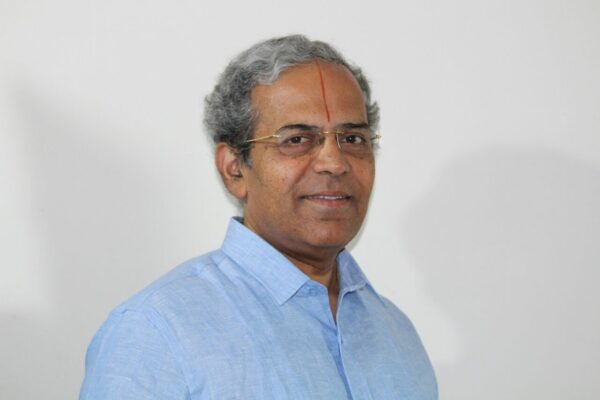
Vid. Ranganath Chakravarthy is a renowned musician. With his vast scientific and technical knowledge, he holds an important position in a multinational engineering industry
*********

